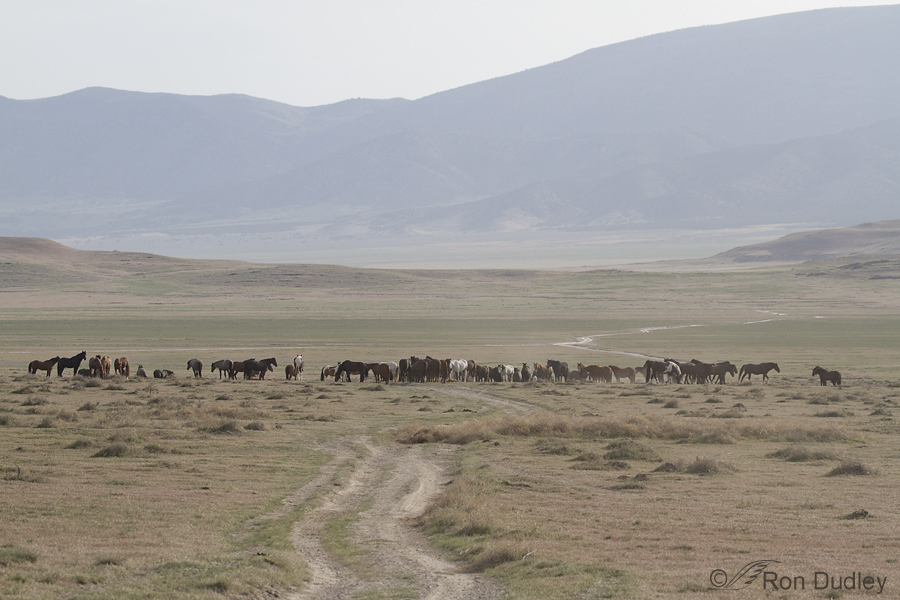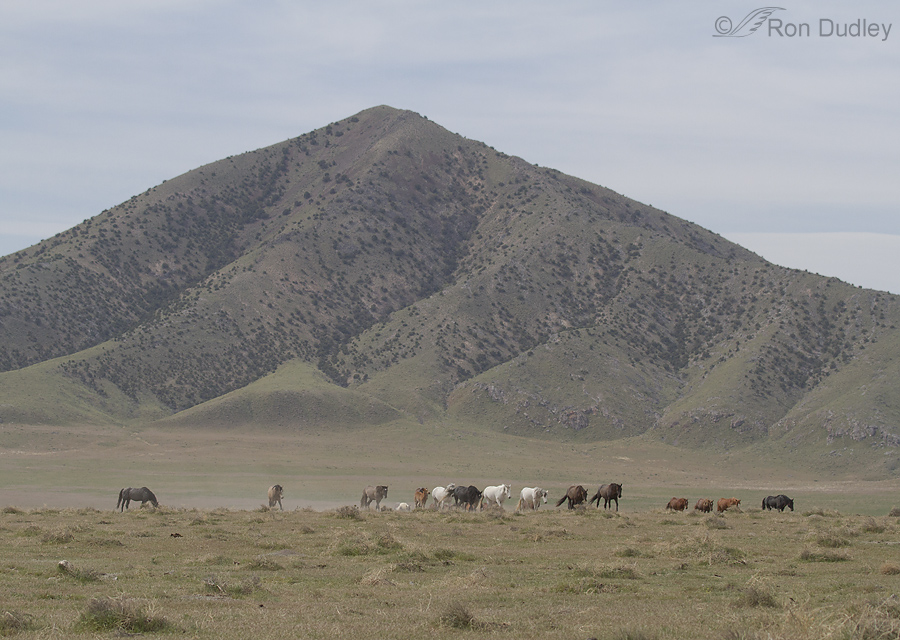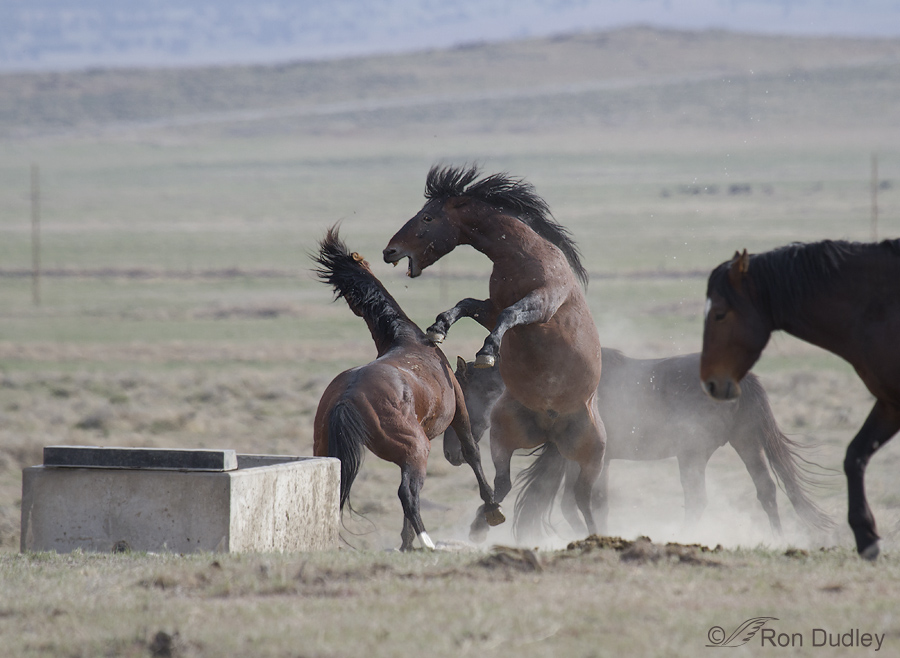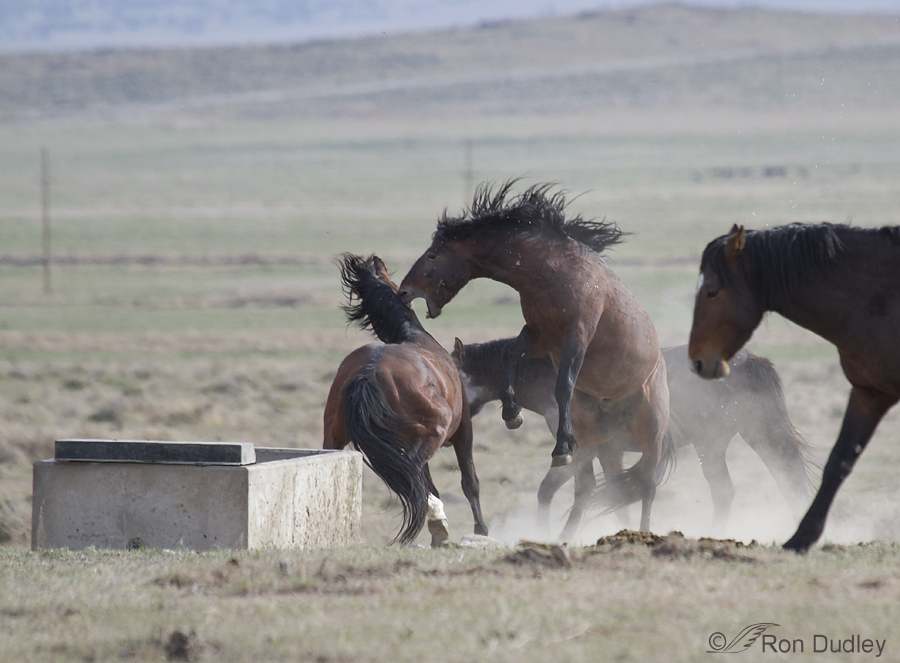Yesterday we had an incredible morning with a herd of wild horses in the west desert of Utah. It was a learning experience for me on many levels. It was so very interesting to watch the behaviors and interactions between the horses, especially this time of year when so much is going on but since this was my first experience photographing them I made many mistakes with lighting, timing, camera settings and even choice of camera gear – mistakes I hope not to repeat in the future.

This was the herd on the desert floor as we approached. I was slightly surprised that there was so many of them (there are others that you can’t see here).

As the horses grazed a few groups of them would move off in different directions. Later in the morning this band was returning to a cement water tank, presumable placed there by the BLM for their use. Much of the time everything seemed relatively peaceful on the surface but that was really an illusion – there was lots of simmering tension, especially between the stallions. Fights broke out regularly but unpredictably – at least it was mostly unpredictable for me because of my lack of skill at reading their behaviors.
The prevailing mood would seem calm for a while and then in an instant…

all hell would break out.
This image and the following two are sequential shots in a burst. The horses are side lit and the water tank isn’t pretty but I thought the action was pretty dramatic.

Notice how calm the other horses are amid all the excitement. These fights break out so regularly that noncombatants usually seem to take them in stride.
Though it’s difficult to make out, the horse on the left seems to be reacting to being bitten on its upper chest. After this shot was taken the fight was over almost as quickly as it began.
I’ll be posting more images of these wild horses over the next few weeks. Many, many thanks to our new friend Wade Haskell for introducing us to the herd. Wade is my kind of guy on many levels, not the least of which is the tremendous respect he has for these horses that he loves so dearly.
Ron
PS – sorry for the silly typo that went out with the subscription email to this post. Yes, I do know the difference between desert and dessert…



Hi Ron:
My friend P.J. Clark forwarded this on to me as she knows how much I love wild horses. I have only been able to photograph at Return To Freedom American Wild Horse Sanctuary in Lompoc, CA which is amazing, yet I still would like to photograph in other states and in the wild. I love your shots and was wondering if you will be leading tours at all or who you would recommend. I am slowly starting to save up my money so I can pursue my dream of photographing wild horses in various states. I do live in CA but I believe most wild horses are in other states.
I have become involved educating others about the plight of our American wild horses and what we can do to bring awareness and hopefully protect them. Love your shots and looking forward to more.
Email sent, Susan.
Too bad that cement thing is in the shot but maybe it is for water. Great action, would have been exciting.I have seen horses inflict damage right in the farmyard.Tim’s comment is thoughtful though not popular here in Alberta where the issue of Wild horses is highly controversial and volatile.I am going out on a limb here but I do see both sides of the issue. I am up for more photos, please.
Wow. An incredible sight.
I am so NOT going to show these to my partner. He believes that horses are tricky and mean spirited. He tells me that when you read about a single car accident on a deserted road if you go to the ‘scene of the crime’ you will discover at least one horse in a nearby paddock. A horse which has leapt out in front of the car, caused it to swerve and crash, and then hopped back into the paddock pretending innocence…
Nice action shots of these symbols of the American west. I managed to get some photos of the Simpson Springs herd and when I got the images up on the computer I was surprised to see several animals with brands. Yes, feral horses. I know there is a big controversy between ranchers and the BLM regarding wild horses, but if branded horses are becoming part of the herd perhaps a few ranchers, not all, are actually contributing to the growing problem by turning unwanted animals loose on BLM range. However, for an OLD city slicker like me it is still very exciting to see your impressive images of these magnificent animals.
In the past several years many horse owners became unable to keep their horses – many people who lost their jobs, or even their homes – and cannot find someone to sell or even give them to. So they are surreptitiously dropping them off in pastures, tying them to horse trailers, or even turning them out on the range. Yet another sad consequence of the not-so-Great Recession.
I have seen horses fighting in CA ranches. They start suddenly, and end within a minute or so. sometime, one horse start to pick fight with 2 or 3 different horses. I once captured them after I bought my DSLR,3 years back. It was so sudden and I was so new to photography, that I just shoot them in Auto, and continuous mode. But I loved those. And I love your shots too. Will wait to see more.
This is not as violent as it might seem. It’s very dramatic, and clearly there was a bite. But, these may be two stud horses, or an older and younger stud, etc., one just making a point about territory, or manners, or whatever, to the other. Mares can be just as ugly to each other, and lead mares (who are really the ones in charge, not the stud horses), can be a bit vicious to a yearling or two-year old that they are expelling from the herd (basically telling the young boy-horse to go find his own harem). My eldest horse, 30 y.o. at the time, showed those teeth in a threat to a younger horse he’s known for years, just a friendly reminder of who’s boss. Much more serious fights include severe injuries and death. You are not in My Friend Flicka Land. In the meantime, they are great fun to observe, and my favorite photographic art subject. I envy your opp to see wild herds.
Thank you, Ron, for posting these images. They remind me of my rare and poignant encounters with wild horses in Nevada. In response to Tim’s comments, and also Deb’s, the wild horse issue is highly political and if we’re concerned about our ecosystems, we’ll look first to the impacts of livestock grazing on habitat and ecology. It’s impossible to understand the place of wild horses in our ecosystem without taking into consideration the broader picture of what we and our industries inflict on that same terrain. Policy is generally skewed against horses in favor economic interests. Sadly, and not surprisingly, this is often the case when the well-being of wildlife intersects with human interests.
As far as humane slaughter for horses, it’s somewhat of an oxymoron in general if you’ve ever seen commercial slaughter. My understanding is that for horses, it’s particularly gruesome, given the physiology of the horse and the general methodology of slaughterhouses. I urge anyone interested in this issue to read Vickery Eckhoff’s work in Forbes and elsewhere. When you look at the push for reopening the horse slaughter industry in the U.S., it’s being billed as a humane option to transporting horses across the border. But there are, again, economic interests who would benefit clearly from this arrangement. The issue is almost never what it appears to be nor what we’re told it is.
Ingrid, I agree that the issue is politicized, which of course is part of the problem, as politics pretty much excludes rational thinking in favor of emotional appeals.
Horses have always been an economic interest – until quite recently, a valuable good – in the American West, so it’s not clear to me why economic interests should not affect decisions today. If we try to prevent anyone from gaining economic benefit from wild horse management, we remove most of the incentives for people to do such management. That leaves it up to politics and the BLM, which is how we got where we are – a situation nobody seems happy with.
Tim, you write, “horses have always been an economic interest – until quite recently, a valuable good – in the American West, so it’s not clear to me why economic interests should not affect decisions today.” Perhaps because we ought to have moved into a more progressive model of wildlife conservation, where the economic interests of ranchers, as one example, don’t always trump the needs of wild animals. When you look at Wildlife Services and other agencies effectively in the employ of these industries, wildlife gets the short shrift in ways that suggest ownership over stewardship, and sometimes outright abuse. I happen to believe animals have inherent value beyond the self-interested value we place on them. The fallacy of tradition doesn’t work for me.
Ingrid, I think if you asked ranchers, they would not agree that their needs always trump those of wild animals when decisions are made by government agencies. They are just as mad about the decisions that go against them, as conservationists are about the decisions that don’t.
The wild-horse issue brings in a lot of serious unanswered questions about how we value wildlife. They are basically a naturalized feral population, similar to European Starlings or zebra mussels, but we place drastically different values on those species. We don’t seem to look at Nature in a very natural way.
I sure agree that we need a more progressive model of wildlife conservation. How to get one, and what it would look like, are questions we aren’t going to answer in a comment trail!
I agree that the classification of wild horses is contentious, but it’s also incorrect to say they are similar to European Starlings or zebra mussels, understanding the various studies done on the mustang’s relation to E. caballus and so forth. You’ve undoubtedly heard the term “reintroduced native species” in response to the feral arguments. But, then, my bias shows in that I’m not one to demonize a long-established species for its non-native status. I think conciliation biology — exploring the broader role of a species, way beyond a narrow definition like “invasive” — is part of a progressive model of wildlife conservation.
Very cool shots Ron! I am a horse lover from the second I was born & think they most definitely have a place in our western landscape. However, in too large of numbers they are very damaging to the landscape & compete for grazing with not just cows, but all the other critters on the land. I also don’t agree with the BLM holding facilities where they are fed by the tax payers for their considerably long lives. The fact that this country has nixed all the horse slaughter facilities is ridiculous. Not only do we not have any where to humanely take our old horses to send them to the happy riding trails in the sky the BLM could send the excess horses there to actually help pay for the management of the ones we get to view in the wild. JMO Signed, DEB in MT A horse lover.
How many wild horses are too many?
I grew up on horseback. My father was the most horse-crazy guy you ever met. Yet he was appalled at the proliferation of wild horses and the damage they were doing. Our romantic and emotional view of these magnificent animals prevents us from thinking rationaly about their place in the ecosystem.
Thanks for your perspective on this, Tim.
Hi Ron
The reason I like/love your bird photos is the cleanness, the light, the attention you put in every small detail.
Nothing wrong in trying new paths and challenges, after all that’s what life is all about.
Too soon to say anything and yet I am curious, to say the least…
I wish you well in this new adventure.
Thanks, Jorge.
I’ve been in love with horses as early as I can remember…started riding at two…have had a couple of special ones of my own, including one super special best buddy…two of my grandsons have 4 legs each and an Arab background…these photos, yours and Mia’s, are a real treat!!! Am amazed at the numbers (looks like at least 40-50, and you say there were more off camera)…and a bit worried by them, too…seems like a real invitation to the BLM to get involved and, in my experience, that’s NOT a good thing. My guess is that the water is meant for cattle, as it almost ALWAYS is, not for horses or anything else. This can be a BIG problem…often with a very sad, tragic outcome for the horses . These shots are phenomenal!!! I LOVE them!!!! I would have been too excited to focus my camera!!! Love the different colors and markings, too. By the way, this is “dessert” , not “desert” for me!
Thanks, Patty. You could very well be correct about who the water was meant for. And yes, the BLM has plans to reduce the size of our wild horse herds. I’m not happy about that!
Beautiful!! I follow several groups of wild horses on Facebook through groups who regularly photograph them, and support the preservation of the wild horse. I look forward to more of your pictures!
I support their preservation too, Leisa. They need all the support they can get here in Utah as there’s a lot of pressure to reduce the herds.
New horizons to explore…this will be a treat for all of us! You did a wonderful job at capturing the raw, exploding tension. Thanks for inviting us along.
And thanks for joining in the adventure, Cheryl.
How exciting for you! And how exciting for us to be able to witness through your photos this interesting behavior. The concrete ‘box’ is not attractive but so nice to see that the horses always have a water supply. Thanks again Ron.
Ellen, I’m not sure how the horses would survive without the provided water – it’s incredibly hot and dry out there during summer. I suspect cattle drink out of it also.
Magnifient!!
Thank you, Lois.
Very nice action shots! Do you think any of these horses get seriously hurt
during these skirmishes?
Yes, I do Bill. One of the stallions had a very large wound on its flank. At this point it was healing nicely but Wade said the wound was just open, red meat a few weeks earlier. Another horse was limping badly and I suspect it was probably from fighting. Most of the adult horses had multiple scars. During fights their kicks were incredibly powerful and quick. I’ll post pics of that in the future.
Very interesting photos. Much as I love perfection in shots, reasonably good shots showing behavior are always worthwhile and interesting.
That’s the way I feel about it too, Susan. Less than perfect documentary shots of behaviors are often worth seeing. Thank you.